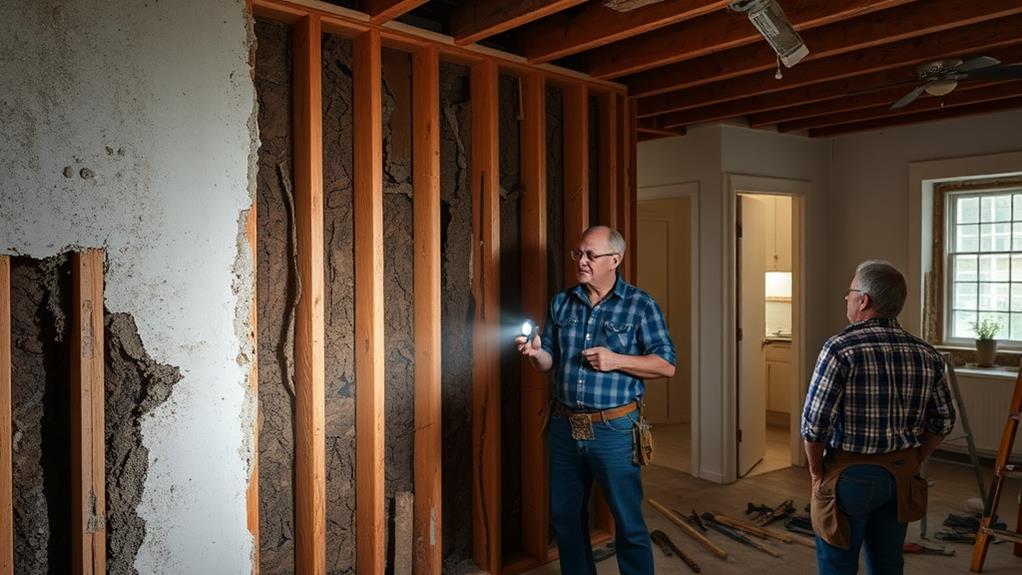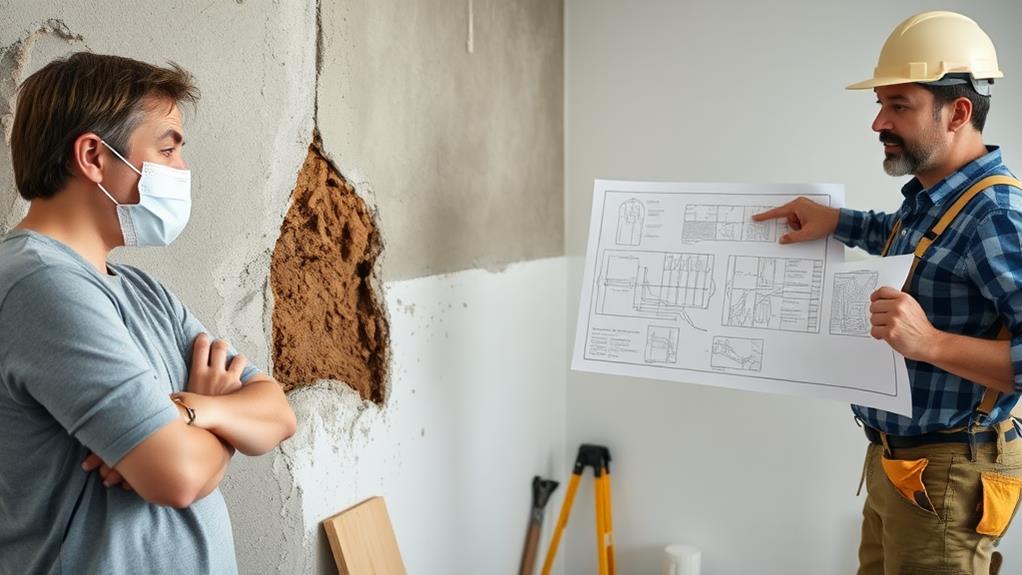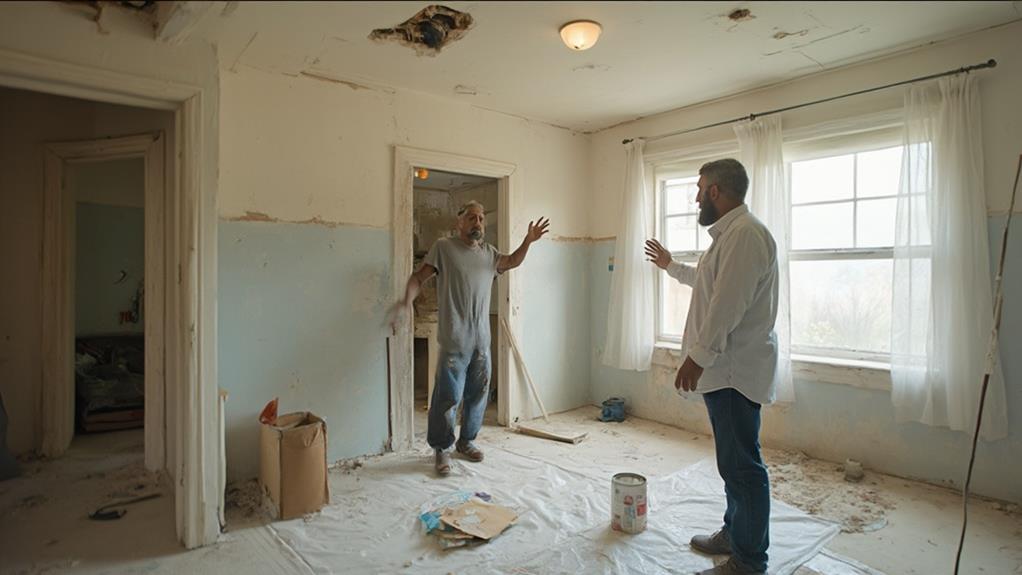Successful renovations often face unexpected challenges that can derail timelines and budgets. Common issues include hidden structural problems, permit hurdles, contractor reliability concerns, and material shortages. To manage these setbacks, homeowners should establish a detailed budget with a 10-20% contingency fund, thoroughly vet contractors, and maintain open communication with all parties involved. Implementing a change order system, exploring value engineering options, and building buffer time into the project schedule can help mitigate risks. By anticipating potential roadblocks and remaining adaptable, renovators can navigate unforeseen circumstances more effectively. Proper preparation and a flexible mindset are key to keeping projects on track when plans go awry.
Hidden Structural Problems

While renovating a home can be an exciting endeavor, hidden structural problems often lurk beneath the surface, potentially derailing even the most carefully planned projects. These issues can range from minor inconveniences to major safety hazards, and may include water damage, foundation cracks, outdated wiring, or pest infestations. Uncovering these problems during renovations can lead to unexpected costs, extended timelines, and significant stress for homeowners.
To mitigate the impact of hidden structural issues, it's crucial to conduct thorough inspections before beginning any renovation work. Hiring qualified professionals, such as structural engineers or certified home inspectors, can help identify potential problems early on. Additionally, maintaining a contingency fund of 10-20% of the total renovation budget can provide a financial buffer for addressing unforeseen issues.
When structural problems are discovered mid-project, it's essential to prioritize safety and compliance with building codes. This may require adjusting renovation plans or even halting work temporarily. Open communication with contractors and local building authorities is key to navigating these challenges effectively and ensuring that all necessary repairs are completed properly before proceeding with cosmetic improvements.
Permit and Regulatory Hurdles
Beyond the challenges of hidden structural issues, homeowners often face significant permit and regulatory hurdles during renovation projects. These obstacles can delay timelines, increase costs, and sometimes even halt work entirely. Local building codes and zoning regulations vary widely between jurisdictions, making it crucial for homeowners to research and understand their specific requirements before starting any renovation.
Common permit-related issues include obtaining the correct permits for structural changes, electrical work, plumbing modifications, and additions. Failure to secure proper permits can result in fines, forced removal of completed work, or difficulty selling the property in the future. Additionally, historical preservation regulations may limit changes to older homes, while environmental regulations might affect projects in sensitive areas.
To navigate these challenges, homeowners should:
- Consult with local building departments early in the planning process
- Work with experienced contractors familiar with local regulations
- Allow extra time and budget for potential permit-related delays
- Consider hiring an architect or permit expediter for complex projects
- Keep detailed records of all permit applications and approvals
Contractor Reliability Issues

Three major contractor reliability issues can derail renovation projects: incompetence, dishonesty, and poor communication. Incompetence manifests through subpar workmanship, missed deadlines, and failure to adhere to building codes. This can result in costly rework, project delays, and potential safety hazards.
Dishonesty may involve inflated estimates, use of inferior materials, or misrepresentation of qualifications. Such practices can lead to budget overruns and compromised quality.
Poor communication often results in misunderstandings about project scope, timelines, and expectations. This can cause frustration, delays, and disputes between homeowners and contractors.
To mitigate these risks, thoroughly vet potential contractors by checking references, verifying licenses, and reviewing past projects. Insist on detailed, written contracts that clearly outline project specifications, timelines, and payment schedules. Regular progress meetings and open lines of communication can help address issues promptly. Consider hiring a project manager or consultant to oversee complex renovations and act as a liaison between you and the contractor.
If problems persist, document all issues and seek legal advice if necessary to protect your interests and ensure project completion.
Budget Overruns
Budget overruns are a common and often significant challenge in renovation projects. They can occur due to various factors, including unexpected structural issues, changes in material costs, or scope creep. To mitigate the risk of budget overruns, it's crucial to establish a detailed and realistic budget from the outset, incorporating a contingency fund of 10-20% for unforeseen expenses.
Regular communication with contractors and suppliers is essential to stay informed about potential cost increases. Implement a change order system to document and approve any modifications to the original plan, ensuring all parties understand the financial implications. Prioritize essential renovations and be prepared to make compromises on less critical aspects if costs escalate.
Consider value engineering options to reduce expenses without compromising quality. This may involve exploring alternative materials or construction methods that achieve similar results at a lower cost. If budget overruns become unavoidable, explore financing options such as home equity loans or lines of credit to cover the additional expenses. Remember that addressing budget issues promptly and transparently can help maintain positive relationships with contractors and keep the project on track.
Timeline Delays

Navigating timeline delays is a critical aspect of managing unexpected renovations. These setbacks can occur due to various factors, including unforeseen structural issues, material shortages, or permit complications.
To mitigate the impact of delays, it's essential to build buffer time into the project schedule and maintain open communication with all stakeholders.
When delays occur, prioritize tasks and adjust the workflow to minimize downtime. Consider parallel processing of activities where possible, and be prepared to reallocate resources to keep the project moving forward. It's crucial to document all delays and their causes, as this information may be necessary for contract negotiations or insurance claims.
Regularly update clients on the revised timeline and explain the reasons for any extensions. Provide realistic estimates for completion and avoid overpromising. If significant delays are anticipated, explore temporary solutions to minimize disruption to the occupants or business operations.
Lastly, learn from each delay to improve future project planning. Analyze the root causes and develop strategies to prevent similar issues in subsequent renovations, enhancing overall project management efficiency.
Material Shortages
Supply chain disruptions can wreak havoc on renovation projects, causing material shortages that lead to delays and increased costs. These shortages can affect various components, from lumber and steel to specialized fixtures and appliances. To mitigate the impact, contractors and homeowners must stay informed about potential supply issues and plan accordingly.
One strategy is to order materials well in advance, even before the project begins. This proactive approach can help secure necessary supplies and potentially lock in prices before they rise. Additionally, considering alternative materials or sourcing from multiple suppliers can provide flexibility when faced with shortages.
Communication between contractors, suppliers, and clients is crucial during material shortages. Regular updates on availability and potential substitutions can help manage expectations and prevent misunderstandings. In some cases, adjusting the project timeline or sequence of work may be necessary to accommodate delayed deliveries.
Homeowners should also be prepared for potential budget increases due to material shortages. Setting aside a contingency fund can help absorb unexpected costs and keep the project moving forward. By anticipating and planning for material shortages, renovators can better navigate these challenges and minimize their impact on the overall project.
Unforeseen Environmental Concerns

While material shortages can pose significant challenges, unexpected environmental issues can also arise during renovations, potentially causing delays and additional expenses. Common environmental concerns include the discovery of asbestos, lead-based paint, mold, or soil contamination. These issues often require immediate attention and specialized remediation efforts to ensure the safety of workers and future occupants.
Asbestos, commonly found in older buildings, demands professional removal due to its health risks. Lead-based paint, prevalent in structures built before 1978, necessitates careful handling and disposal. Mold infestations may indicate underlying moisture problems that need addressing before renovation can continue. Soil contamination might require extensive testing and cleanup, particularly in industrial or historically contaminated areas.
To mitigate the impact of unforeseen environmental issues, consider conducting thorough pre-renovation inspections and environmental assessments. Budgeting for contingencies can help absorb unexpected costs. Familiarize yourself with local environmental regulations and engage with experienced professionals who can quickly identify and address potential hazards. Maintaining open communication with contractors and regulatory bodies throughout the renovation process can help manage these challenges more effectively and keep the project on track.
Design Changes Mid-Project
Despite careful planning, design changes during a renovation project are not uncommon and can significantly impact both timeline and budget. These alterations may arise from various sources, including unforeseen structural issues, changes in client preferences, or newly available materials and technologies.
To manage design changes effectively, establish a clear change order process at the project's outset. This should outline the steps for requesting, evaluating, and approving modifications. Communicate openly with all stakeholders about the potential consequences of changes, including cost increases and schedule delays. Prioritize changes based on necessity and impact, focusing on those that align with the project's core objectives.
When design alterations occur, reassess the project timeline and adjust schedules accordingly. Be prepared to reallocate resources and renegotiate with subcontractors if necessary. Document all changes meticulously, updating plans, specifications, and budgets to reflect the new scope of work. Consider implementing a contingency fund specifically for design changes to mitigate financial risks. By maintaining flexibility and proactive communication throughout the renovation process, you can navigate design changes more smoothly and minimize their disruptive impact on the overall project.
Frequently Asked Questions
How Can I Maintain a Good Relationship With Neighbors During Noisy Renovations?
To maintain good relationships with neighbors during noisy renovations, communicate openly about your plans, provide a timeline, and offer advance notice of particularly disruptive work. Consider setting quiet hours and be receptive to their concerns and feedback.
What Insurance Coverage Should I Have for Home Renovation Projects?
Ironically, the most crucial insurance is the one you hope never to use. For renovations, ensure you have comprehensive homeowner's insurance, contractor's liability coverage, and consider builder's risk insurance for extensive projects. Don't forget permits and inspections!
How Do I Handle Disagreements With My Spouse/Partner About Renovation Decisions?
To handle renovation disagreements with your spouse/partner, focus on open communication, compromise, and prioritization. Consider creating a shared vision board, setting a budget together, and consulting a neutral third party for mediation if necessary.
Are There Tax Implications or Deductions Associated With Home Improvements?
When it comes to home improvements, you can't have your cake and eat it too. Tax implications vary, but some renovations may qualify for deductions. Energy-efficient upgrades often offer tax credits, while other improvements might increase your property's basis.
What Temporary Living Arrangements Should I Consider During Major Home Renovations?
Consider temporary living arrangements such as short-term rentals, extended-stay hotels, or staying with family during major home renovations. Alternatively, if feasible, create a livable zone within your home, separate from the construction area, for temporary accommodation.
Conclusion
Renovations often encounter unexpected challenges, necessitating adaptability and strategic problem-solving. Effective project management involves anticipating potential issues and developing contingency plans. Interestingly, a National Association of Home Builders study found that 85% of home renovation projects exceed their initial budget. This statistic underscores the importance of financial cushioning and realistic expectations. By addressing hidden structural problems, regulatory hurdles, contractor issues, and other unforeseen complications proactively, homeowners can navigate the renovation process more successfully, minimizing stress and maximizing satisfaction with the final result.

